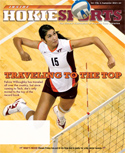The compliance corner answers questions concerning the governance of intercollegiate athletics and its impact on our athletics department. Have a question? Please send it to hokipoki@vt.edu and we’ll answer it in upcoming issues.
Now, here are a couple of questions that we’ve received from Tech alums and fans over the past few months, with responses from Tim Parker, senior assistant AD for compliance:
Q: What exactly is a secondary violation? I know they aren’t as serious as major violations, but what would be some examples of secondary violations? Jeremy in Martinsville, Virginia.
TP: “According to NCAA legislation, secondary violations are those that: 1) are inadvertent, 2) are isolated, and, 3) result in a minimal competitive or recruiting advantage. That’s why the punishment for breaking these rules is not as severe as with major violations.
“Let me give you an example – and this occurred at a school from another conference within the past year. Basketball teams aren’t allowed to have more than four players working out together with coaches prior to the official start of their official ‘playing and practice season’ But, because a second group of players was stretching on the court while a first group’s instructional session was going on, a violation occurred. As a self-imposed penalty, that school will give up one week of ‘skill instruction’ in August (players are allowed two hours in a week).
“In this case, there wasn’t an intent to break the rules. Intercollegiate athletics programs the size of Virginia Tech are expected to self-report between 10 and 25 secondary violations annually (this indicates that the monitoring systems are active and functioning). The NCAA enforcement staff provides a listing of ‘prescribed penalties’ for many types of secondary violations. These are based on case precedent, and create a degree of consistency nationwide when dealing with these transgressions. For those violations that do not have prescribed penalties, there is a searchable database of case precedent that helps us self-impose a reasonable response consisting of one or more actions. These responses almost always include an educational component and corrective action(s), and usually carry some sort of punitive sanction(s).”
Q: Why is it that Jeremiah Masoli is eligible to play this year? Shouldn’t he have to sit out a year like most players? Doesn’t sound like a fair rule to me. Bill in Danville, Virginia.
TP: “You're referring to the former Oregon quarterback who transferred to Ole Miss. The NCAA originally ruled Masoli ineligible to play this season, but Masoli and Ole Miss appealed that ruling, and the NCAA granted it, thus allowing Masoli to play.
“Masoli had graduated from Oregon already, and there is an NCAA rule that allows a student-athlete to transfer without penalty to a different school if that school offers a graduate program that was not offered as his previous school. The NCAA originally ruled that Masoli was violating the intent of this bylaw after he had been dismissed from the Oregon program, but ultimately reconsidered.
“The reason behind this rule can be traced to a strong desire on the part of the NCAA membership to provide (rather than deny) competitive opportunities to student-athletes who transfer to another school for reasons connected directly to academic pursuits. Also coming into play here is the fact that a student-athlete who has already received his/her baccalaureate degree will nearly always get the ‘benefit of the doubt’ when it comes to the application of NCAA regulations. That degree, after all, is the primary objective of attending college in the first place, right?”




